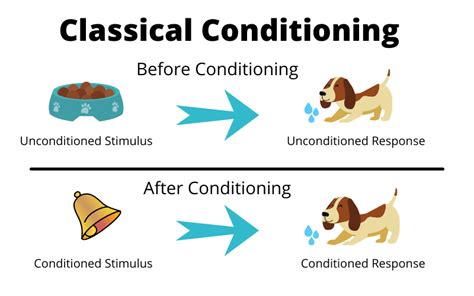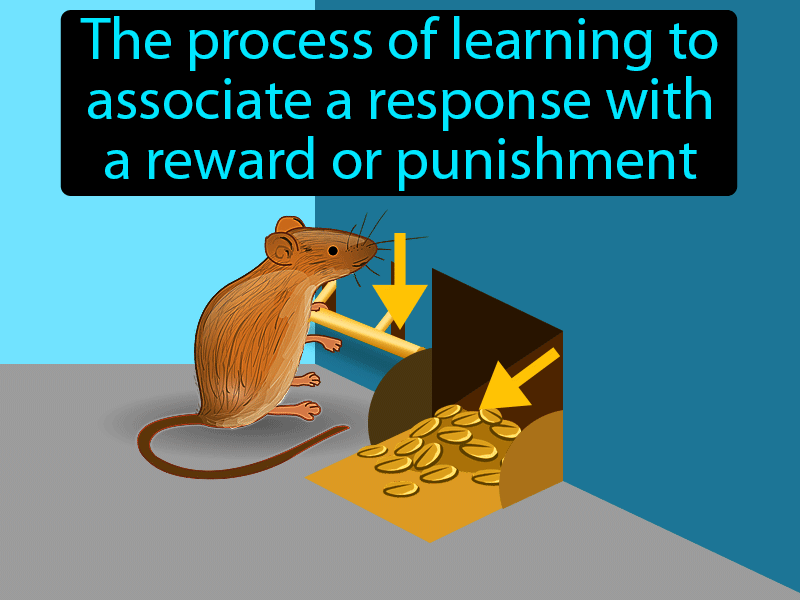Conditioning Definition Psychology

The concept of conditioning is a fundamental aspect of psychology, particularly in the realm of learning and behavior. Conditioning refers to the process by which a stimulus or event becomes associated with a response or behavior, resulting in a predictable and consistent reaction. This association is formed through repeated experiences, leading to the development of a conditioned response.
To understand conditioning, it’s essential to distinguish between two primary types: classical conditioning and operant conditioning. Classical conditioning, discovered by Russian physiologist Ivan Pavlov, involves the association of a neutral stimulus with an unconditioned stimulus to elicit an unconditioned response. Over time, the neutral stimulus becomes a conditioned stimulus, capable of triggering a conditioned response similar to the unconditioned response.
Pavlov’s groundbreaking experiment with dogs is a classic example of classical conditioning. By ringing a bell (neutral stimulus) before presenting food (unconditioned stimulus), Pavlov observed that the dogs eventually began to salivate (conditioned response) in response to the bell alone. This phenomenon illustrates how a previously neutral stimulus can become a powerful trigger for a specific response through repeated pairing with an unconditioned stimulus.
Operant conditioning, on the other hand, is a type of learning in which behavior is modified by its consequences, such as rewards or punishments. This concept was predominantly developed by American psychologist B.F. Skinner. Operant conditioning is based on the idea that behavior is controlled by its environment, and that individuals learn to perform actions that have desirable outcomes and avoid those with undesirable outcomes.
Skinner’s work with operant conditioning chambers, also known as Skinner boxes, demonstrated how behavior can be shaped by reinforcement schedules. By providing rewards, such as food pellets, for specific behaviors, Skinner was able to increase the frequency of those behaviors. Conversely, by introducing punishments or removing rewards, he was able to decrease the frequency of undesired behaviors. This fundamental principle of operant conditioning has far-reaching implications for understanding human behavior, from education to psychotherapy.
Historical Evolution of Conditioning
The concept of conditioning has undergone significant developments since its inception. Pavlov’s classical conditioning and Skinner’s operant conditioning laid the groundwork for subsequent research and theories. One notable expansion is the concept of social learning theory, proposed by Albert Bandura, which suggests that behavior is learned through observation and imitation of others. This theory emphasizes the role of observation, imitation, and reinforcement in shaping behavior, highlighting the complex interplay between environmental and social factors in conditioning.
Comparative Analysis: Classical vs. Operant Conditioning
While both classical and operant conditioning deal with learning and behavior, they differ fundamentally in their approaches and underlying mechanisms. Classical conditioning focuses on the automatic, reflexive responses to stimuli, often involving physiological reactions. In contrast, operant conditioning concentrates on the modification of voluntary behaviors through consequences, emphasizing the role of the environment in shaping behavior.
| Classical Conditioning | Operant Conditioning | |
|---|---|---|
| Focus | Automatic responses to stimuli | Voluntary behavior modification |
| Mechanism | Association through pairing | Consequences (rewards/punishments) |
| Key Figures | Ivan Pavlov | B.F. Skinner |

Case Study: Applying Conditioning Principles in Real-World Scenarios
Understanding conditioning principles has numerous practical applications across various fields, including education, psychology, and marketing. For instance, in education, teachers can use operant conditioning techniques, such as positive reinforcement, to encourage desired behaviors and improve student engagement. In psychology, therapists might employ classical conditioning principles to help patients overcome phobias by gradually exposing them to the feared stimulus in a controlled environment.
Applying Conditioning in Education:
- Identify Desired Behavior: Determine the behavior or action you want to encourage or discourage.
- Choose Reinforcement: Select an appropriate reward or consequence that aligns with the behavior and the individual's preferences.
- Implement Reinforcement Schedule: Decide on a schedule for delivering the reinforcement, which could be fixed, variable, or based on a specific performance criterion.
- Monitor and Adjust: Continuously monitor the behavior and adjust the reinforcement strategy as needed to optimize the desired outcome.
Future Trends Projection: The Evolution of Conditioning
As our understanding of the human brain and behavior continues to evolve, so too will the principles of conditioning. Advances in neuroscience and psychology are likely to reveal new insights into the neural mechanisms underlying classical and operant conditioning, potentially leading to more sophisticated and targeted applications. The integration of conditioning principles with emerging technologies, such as AI and virtual reality, may also open up innovative avenues for behavioral modification and learning.
Technical Breakdown: Neural Mechanisms of Conditioning
The neural basis of conditioning involves complex interactions between various brain regions, including the amygdala, hippocampus, and prefrontal cortex. Classical conditioning, for example, is associated with changes in the strength of synaptic connections between neurons in the cerebellum and other parts of the brain. Operant conditioning, on the other hand, involves the dopamine system, with the release of dopamine reinforcing desired behaviors and motivating future actions.
Conceptual Exploration: Theoretical Underpinnings
Conditioning theories are rooted in behavioral and cognitive psychology, emphasizing the role of environment and experience in shaping behavior. However, these theories also have implications for our understanding of free will, personal responsibility, and the nature of consciousness. By examining the theoretical underpinnings of conditioning, researchers can better understand the interplay between genetic predispositions, environmental influences, and individual choices in determining human behavior.
Myth vs. Reality: Common Misconceptions About Conditioning
Despite its significance, conditioning is often misunderstood or oversimplified. One common myth is that conditioning can control behavior in a deterministic manner, ignoring the complexity of human decision-making and the role of cognition. Another misconception is that conditioning is limited to simple behaviors, when in fact, it plays a crucial role in complex emotional and cognitive processes.
Pros and Cons of Conditioning in Practice:
Advantages:
- Effective in modifying behavior and learning new responses.
- Can be applied in various contexts, from education to therapy.
- Provides a systematic approach to understanding and predicting behavior.
Disadvantages:
- Can be manipulative if not used ethically, potentially infringing on personal autonomy.
- May not account for the complexity of human emotions and cognitive processes.
- Requires careful consideration of the reinforcement schedule to avoid unintended consequences.
Decision Framework: Applying Conditioning Principles
When considering the application of conditioning principles, whether in personal or professional contexts, it’s crucial to approach the situation with a thoughtful and structured decision-making process. This includes:
- Identifying Goals: Clearly define what behaviors or outcomes you aim to achieve or modify.
- Selecting Conditioning Type: Determine whether classical or operant conditioning is more appropriate for the situation.
- Designing the Intervention: Develop a specific plan for implementing the conditioning technique, including the choice of stimuli, reinforcement schedule, and monitoring strategy.
- Evaluating Ethics: Consider the ethical implications of using conditioning, ensuring that the approach respects individual autonomy and dignity.
- Assessing Outcomes: Regularly evaluate the effectiveness of the conditioning strategy and make adjustments as necessary to achieve the desired outcomes.
Conclusion
Conditioning, as a psychological concept, offers profound insights into the mechanisms of learning and behavior. By understanding the principles of classical and operant conditioning, individuals can better navigate their environment, make informed decisions, and potentially modify undesired behaviors. As research continues to elucidate the complexities of human behavior and the neural underpinnings of conditioning, the applications of these principles are likely to expand, leading to more effective strategies for personal growth, education, and psychological intervention.
What is the primary difference between classical and operant conditioning?
+Classical conditioning involves the association of a neutral stimulus with an unconditioned stimulus to elicit an unconditioned response, whereas operant conditioning modifies behavior through consequences such as rewards or punishments.
How can conditioning principles be applied in real-world scenarios?
+Conditioning principles can be applied in education to encourage desired behaviors, in psychology to help patients overcome phobias, and in marketing to influence consumer behavior, among other areas.
What are the ethical considerations of using conditioning techniques?
+It’s essential to consider the potential for manipulation and ensure that the use of conditioning respects individual autonomy and dignity. The approach should be transparent, voluntary, and aimed at promoting well-being rather than control.

